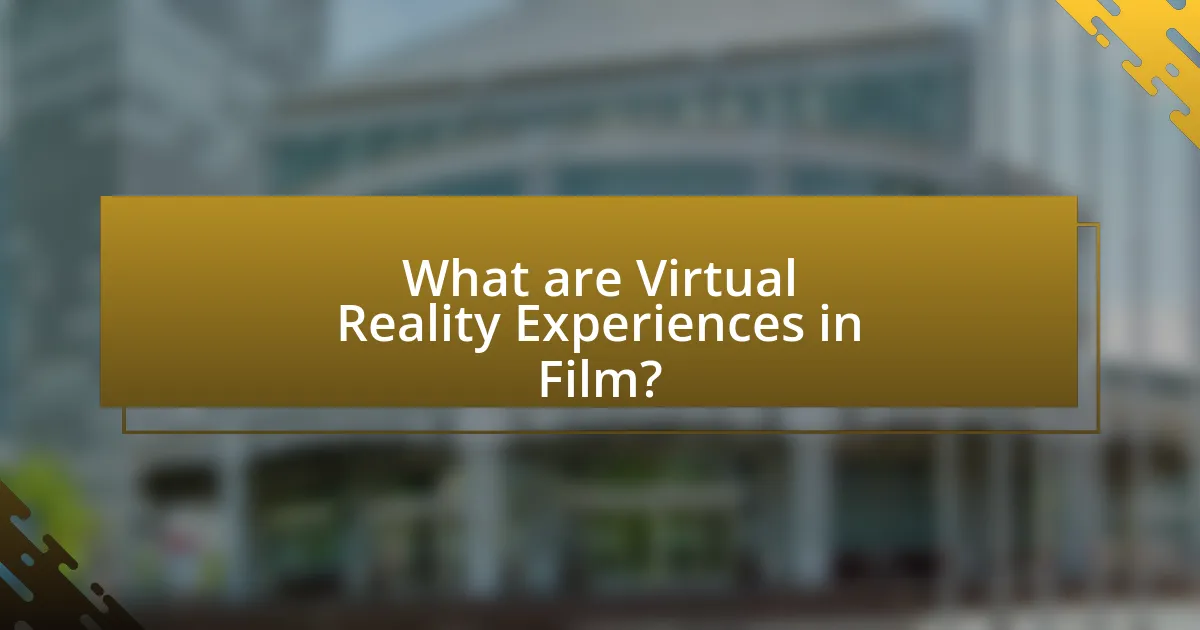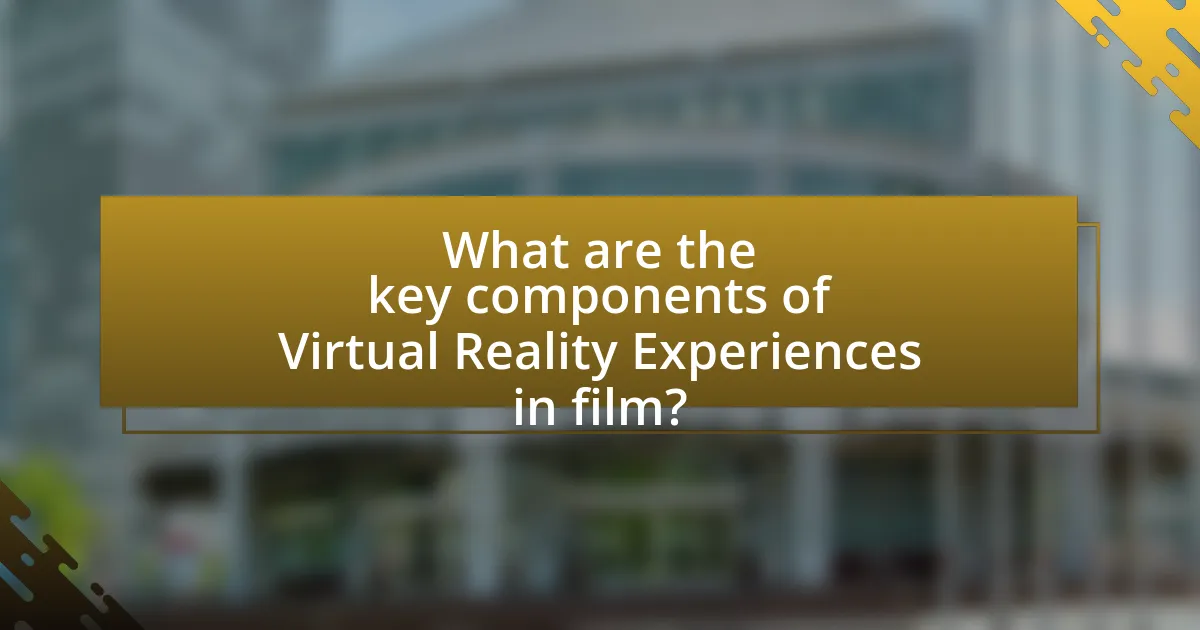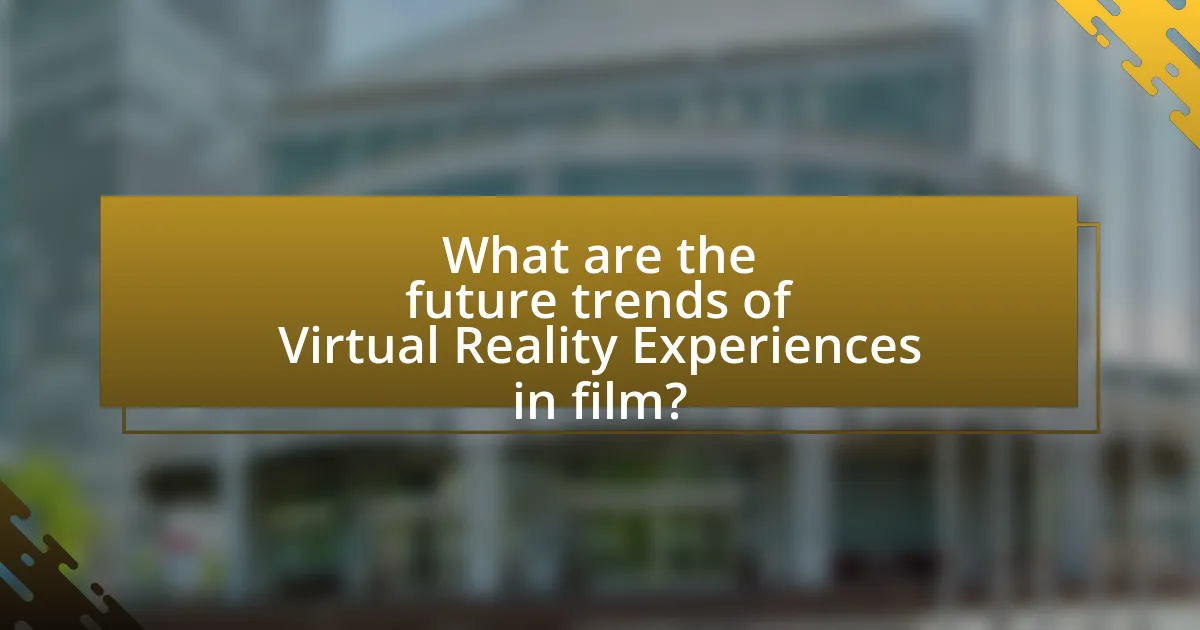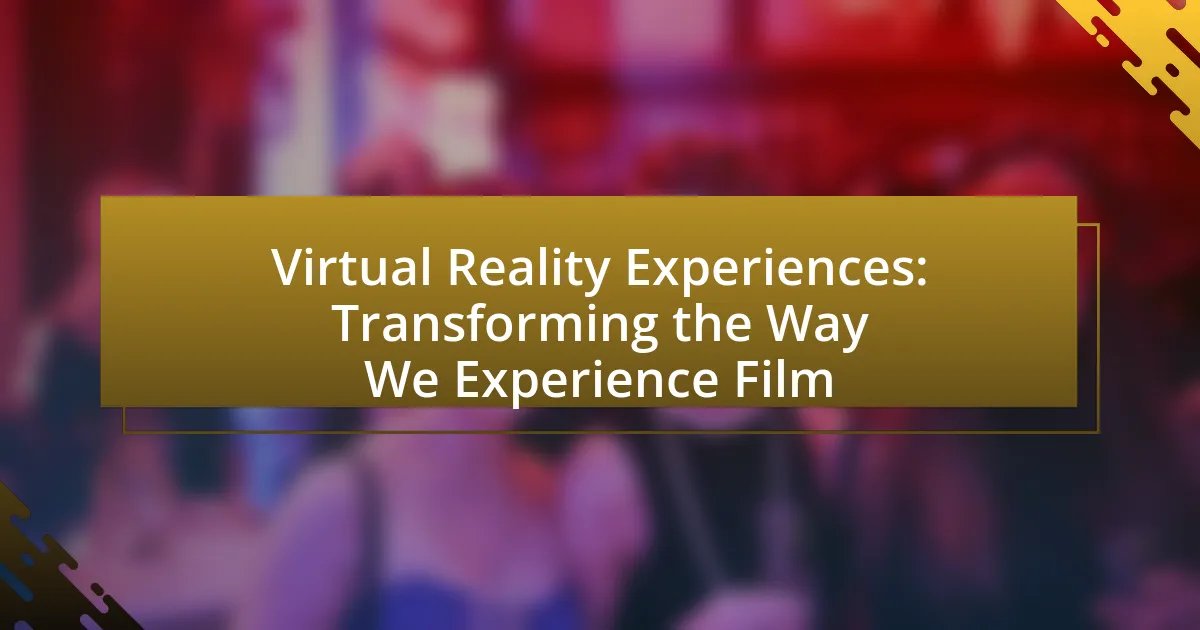Virtual Reality Experiences in film represent a significant evolution in cinematic storytelling, allowing viewers to engage with narratives in immersive, three-dimensional environments. This article explores the differences between traditional film and VR experiences, highlighting the enhanced interactivity and emotional engagement that VR offers. It discusses the technologies enabling these experiences, the importance of immersion, and the growing popularity of VR in the film industry, particularly among younger audiences. Additionally, the article examines the production techniques, challenges, and future trends in VR filmmaking, as well as ethical considerations and best practices for creators.

What are Virtual Reality Experiences in Film?
Virtual Reality Experiences in Film are immersive environments that allow viewers to engage with cinematic content in a three-dimensional space, enhancing emotional and sensory engagement. These experiences utilize VR technology to create interactive narratives where users can explore settings, interact with characters, and influence story outcomes, thereby transforming traditional passive viewing into an active participatory experience. For instance, films like “The Invisible Man” and “The Walking Dead: Saints & Sinners” have successfully integrated VR elements, demonstrating how this technology can deepen audience connection and involvement in storytelling.
How do Virtual Reality Experiences differ from traditional film experiences?
Virtual Reality experiences differ from traditional film experiences primarily in their level of interactivity and immersion. In Virtual Reality, users actively participate in the environment, allowing them to explore and influence the narrative, whereas traditional films present a linear story where viewers passively observe. This interactivity in VR is supported by technology that tracks user movements and actions, creating a personalized experience that can adapt to individual choices. For instance, a study by the University of Southern California found that VR can enhance emotional engagement by 30% compared to traditional media, demonstrating the profound impact of immersive storytelling.
What technologies enable Virtual Reality Experiences in film?
Virtual Reality experiences in film are enabled by technologies such as head-mounted displays (HMDs), motion tracking systems, and 3D audio. HMDs, like the Oculus Rift and HTC Vive, immerse users in a virtual environment by providing stereoscopic visuals and head tracking. Motion tracking systems, including optical and inertial sensors, allow for real-time interaction and movement within the virtual space, enhancing the sense of presence. Additionally, 3D audio technology creates spatial sound that corresponds with the visual elements, further enriching the immersive experience. These technologies collectively transform traditional film viewing into an interactive and engaging experience.
How does immersion play a role in Virtual Reality Experiences?
Immersion is a critical component of Virtual Reality (VR) experiences, as it enhances the user’s sense of presence within a virtual environment. This heightened sense of presence allows users to engage more deeply with the content, making interactions feel more real and impactful. Research indicates that immersive VR experiences can lead to stronger emotional responses and greater retention of information, as users are more likely to feel as though they are part of the narrative. For instance, a study by Slater and Wilbur (1997) demonstrated that increased immersion in VR environments significantly affects users’ emotional engagement and memory recall. Thus, immersion directly influences the effectiveness and enjoyment of VR experiences, particularly in the context of film, where storytelling is paramount.
Why are Virtual Reality Experiences gaining popularity in the film industry?
Virtual Reality Experiences are gaining popularity in the film industry because they offer immersive storytelling that enhances viewer engagement. This technology allows audiences to experience narratives in a three-dimensional space, creating a sense of presence that traditional films cannot achieve. According to a report by the International Data Corporation, the global VR market is expected to grow significantly, with the entertainment sector being a major contributor, indicating a strong trend towards VR adoption in film. Additionally, films like “Ready Player One” and experiences such as “The Lion King VR” demonstrate how VR can create unique, interactive environments that captivate audiences, further validating its rising prominence in filmmaking.
What audience demographics are most attracted to Virtual Reality Experiences?
Individuals aged 18 to 34 are the primary audience demographic attracted to Virtual Reality Experiences. This age group is particularly engaged due to their familiarity with technology and gaming, which are integral to VR. According to a 2021 report by Statista, 54% of VR users fall within this age range, highlighting their significant interest in immersive experiences. Additionally, males represent a larger portion of VR users, comprising approximately 70% of the demographic, driven by interests in gaming and interactive content.
How do filmmakers perceive the value of Virtual Reality Experiences?
Filmmakers perceive the value of Virtual Reality (VR) experiences as a transformative tool that enhances storytelling and audience engagement. They recognize that VR allows for immersive narratives, enabling viewers to experience stories from unique perspectives, which traditional film cannot achieve. For instance, a study by the University of Southern California’s Entertainment Technology Center found that VR can increase emotional engagement by 30% compared to conventional media formats. This heightened engagement is attributed to the interactive nature of VR, which allows audiences to explore environments and narratives actively, rather than passively observing. Consequently, filmmakers view VR as a significant evolution in cinematic expression, offering new creative possibilities and expanding the boundaries of how stories can be told.

What are the key components of Virtual Reality Experiences in film?
The key components of Virtual Reality Experiences in film include immersion, interactivity, and narrative engagement. Immersion is achieved through 360-degree visuals and spatial audio, which create a convincing environment that allows viewers to feel present within the film’s world. Interactivity enables users to influence the storyline or explore the environment, enhancing personal connection and engagement with the content. Narrative engagement is facilitated by storytelling techniques that adapt to the viewer’s choices, making the experience more personalized and impactful. These components collectively transform traditional film viewing into an interactive and immersive experience, as evidenced by projects like “The Invisible Man” VR experience, which utilized these elements to enhance audience involvement.
What types of content are best suited for Virtual Reality Experiences?
Immersive storytelling is the type of content best suited for Virtual Reality experiences. This includes narratives that allow users to engage with the environment and characters in a three-dimensional space, enhancing emotional connection and engagement. For instance, VR films like “The Invisible Man” and “Wolves in the Walls” demonstrate how immersive narratives can create a sense of presence, making viewers feel as if they are part of the story. Additionally, educational content, such as virtual field trips or historical recreations, effectively utilizes VR to provide interactive learning experiences, as evidenced by programs like Google Expeditions. These examples illustrate that content designed for active participation and emotional engagement is most effective in Virtual Reality.
How does narrative structure change in Virtual Reality Experiences?
Narrative structure in Virtual Reality (VR) experiences shifts from linear storytelling to a more immersive, interactive format. In traditional media, narratives typically follow a predetermined sequence, whereas VR allows users to influence the story through their choices and actions, creating a branching narrative structure. This interactivity enhances engagement and personal investment in the story, as users can explore different perspectives and outcomes based on their decisions. Research indicates that this shift can lead to a deeper emotional connection with the narrative, as users feel a sense of agency and presence within the virtual environment.
What role does interactivity play in Virtual Reality film content?
Interactivity is crucial in Virtual Reality (VR) film content as it enhances user engagement and immersion. By allowing viewers to make choices and influence the narrative, interactivity transforms passive viewing into an active experience. Research indicates that interactive elements in VR can increase emotional involvement and retention of information, as users feel a greater connection to the story and characters. For instance, a study by Jerald et al. (2019) found that participants reported higher satisfaction and emotional responses when they could interact with the environment compared to traditional film formats. This demonstrates that interactivity not only enriches the storytelling experience but also fosters a deeper emotional connection with the content.
How do production techniques differ for Virtual Reality Experiences?
Production techniques for Virtual Reality (VR) experiences differ significantly from traditional film production due to the immersive nature of VR. In VR, creators must focus on 360-degree storytelling, requiring specialized cameras and techniques to capture scenes from all angles, unlike conventional film which typically uses a fixed frame. Additionally, VR production emphasizes interactivity, necessitating the integration of user input and real-time rendering, which is not a consideration in standard filmmaking. This shift in focus is supported by the need for spatial audio design, which enhances immersion by simulating sound from various directions, a technique less critical in traditional film.
What are the challenges faced during the production of Virtual Reality films?
The challenges faced during the production of Virtual Reality films include high production costs, technical limitations, and the need for specialized skills. High production costs arise from the advanced technology and equipment required, such as 360-degree cameras and powerful editing software. Technical limitations can hinder the quality of the experience, as issues like latency and resolution can affect viewer immersion. Additionally, the need for specialized skills in areas like 3D modeling, animation, and interactive storytelling complicates the production process, as traditional filmmaking techniques do not directly translate to VR. These factors collectively create significant barriers to producing effective and engaging Virtual Reality films.
How can filmmakers overcome technical limitations in Virtual Reality production?
Filmmakers can overcome technical limitations in Virtual Reality production by leveraging advanced software tools and optimizing hardware capabilities. Utilizing real-time rendering engines like Unreal Engine or Unity allows for high-quality graphics and interactive experiences, which can significantly enhance the viewer’s immersion. Additionally, filmmakers can adopt techniques such as pre-visualization and iterative testing to identify and address potential issues early in the production process. Research indicates that the integration of motion capture technology can also improve character animation and realism, as demonstrated in projects like “The Lion King” (2019), where advanced techniques were employed to create lifelike movements. By combining these strategies, filmmakers can effectively navigate and mitigate the challenges posed by current VR technology.

What are the future trends of Virtual Reality Experiences in film?
Future trends of Virtual Reality (VR) experiences in film include increased interactivity, enhanced storytelling, and the integration of artificial intelligence. Interactivity allows viewers to influence plot outcomes, creating personalized narratives, as seen in projects like “Bandersnatch.” Enhanced storytelling will leverage immersive environments to deepen emotional engagement, supported by advancements in VR technology that provide more realistic visuals and sound. The integration of artificial intelligence will enable dynamic content adaptation based on viewer responses, enhancing the overall experience. These trends are driven by the growing demand for immersive entertainment and advancements in VR hardware and software, indicating a significant shift in how films are created and consumed.
How is technology evolving to enhance Virtual Reality Experiences?
Technology is evolving to enhance Virtual Reality (VR) experiences through advancements in hardware, software, and user interaction methods. Innovations such as higher resolution displays, improved motion tracking, and haptic feedback systems significantly increase immersion and realism. For instance, the introduction of OLED and microLED screens provides sharper images and better color accuracy, while advancements in motion tracking, like inside-out tracking, allow for more natural movement within virtual environments. Additionally, the integration of artificial intelligence enhances user interactions by enabling more responsive and adaptive environments. These developments collectively contribute to a more engaging and lifelike VR experience, as evidenced by the growing adoption of VR in various sectors, including film, gaming, and education.
What innovations are expected in Virtual Reality film equipment?
Innovations in Virtual Reality film equipment are expected to include advancements in resolution, field of view, and tracking technology. Higher resolution displays, such as 8K and beyond, will enhance visual clarity, while wider fields of view will create a more immersive experience. Additionally, improved tracking systems, including inside-out tracking and eye-tracking, will allow for more accurate user interactions and a seamless experience. These innovations are supported by ongoing developments in display technology and sensor capabilities, which are crucial for creating realistic and engaging VR environments.
How might audience engagement change with future Virtual Reality Experiences?
Audience engagement will likely become more immersive and interactive with future Virtual Reality experiences. As technology advances, VR will enable audiences to participate actively in narratives, rather than being passive viewers. For instance, studies indicate that immersive storytelling can increase emotional connection and retention of information by up to 70%, compared to traditional media. This shift will allow audiences to influence plot outcomes and interact with characters, creating a personalized experience that enhances engagement.
What are the potential challenges for Virtual Reality Experiences in film?
The potential challenges for Virtual Reality Experiences in film include high production costs, technical limitations, and audience accessibility. High production costs arise from the need for specialized equipment and skilled personnel to create immersive environments, which can significantly increase budgets compared to traditional filmmaking. Technical limitations, such as hardware constraints and the need for advanced software, can hinder the quality and fluidity of VR experiences, making it difficult to achieve the desired level of immersion. Additionally, audience accessibility is a challenge, as not all viewers have access to VR headsets or the necessary technology, limiting the potential audience size and engagement. These factors collectively pose significant hurdles for the integration of VR in the film industry.
How can filmmakers address accessibility issues in Virtual Reality Experiences?
Filmmakers can address accessibility issues in Virtual Reality (VR) experiences by incorporating features such as audio descriptions, customizable controls, and alternative input methods. These features enhance usability for individuals with visual or motor impairments. For instance, audio descriptions provide essential context for visually impaired users, while customizable controls allow users to adjust settings according to their specific needs, making the experience more inclusive. Research indicates that 15% of the global population has some form of disability, highlighting the importance of these adaptations in VR to ensure equitable access to immersive storytelling.
What ethical considerations arise with Virtual Reality Experiences in film?
Ethical considerations in Virtual Reality (VR) experiences in film include issues of consent, psychological impact, and representation. Consent is crucial as users may be exposed to intense scenarios that require prior agreement to participate. The psychological impact can lead to desensitization or trauma, particularly if the content is violent or disturbing, as studies indicate that immersive experiences can affect emotional responses more profoundly than traditional media. Representation is also significant; VR can perpetuate stereotypes or misrepresent marginalized groups, which can reinforce harmful narratives. These considerations highlight the need for filmmakers to approach VR content with a strong ethical framework to ensure a responsible and inclusive experience for all users.
What best practices should filmmakers follow when creating Virtual Reality Experiences?
Filmmakers should prioritize immersive storytelling, user agency, and spatial awareness when creating Virtual Reality experiences. Immersive storytelling engages users by placing them in the narrative, allowing them to explore environments and interact with characters, which enhances emotional connection. User agency is crucial; filmmakers must design experiences that allow users to make choices, influencing the narrative flow and increasing engagement. Spatial awareness involves understanding how users perceive and navigate 3D spaces, ensuring that the environment feels natural and intuitive. These practices are supported by research indicating that immersive experiences can significantly enhance user engagement and emotional response, as demonstrated in studies by the University of Southern California’s Institute for Creative Technologies, which found that VR can evoke stronger emotional reactions compared to traditional media.

Leave a Reply